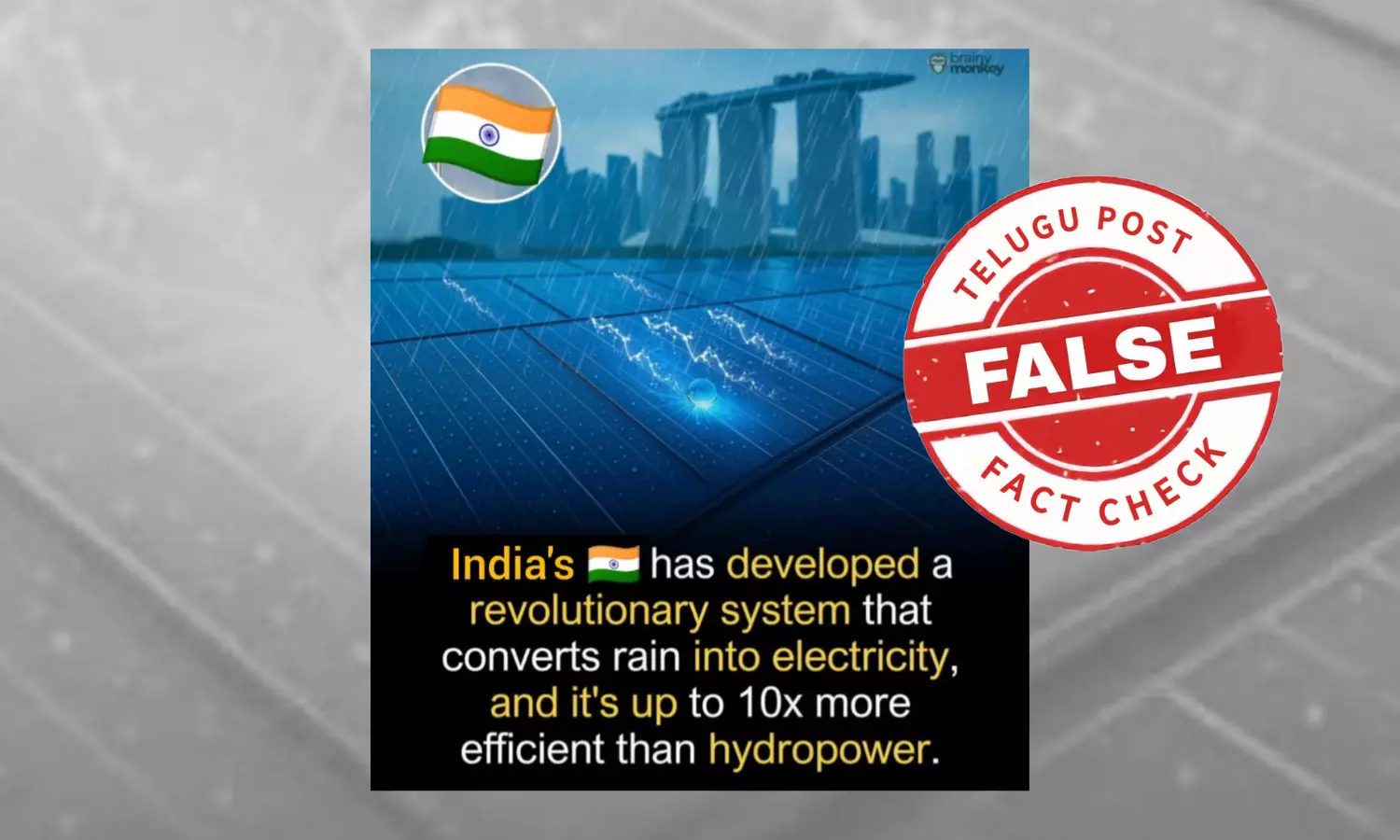Fact Check: Viral Rain Power Claim Linked to India Proven False, Origin Traced to Foreign Lab Research
The claim is false. No such rain-to-electricity system has been developed in India. The real story stems from lab-scale research in Singapore and a few universities exploring triboelectric nanogenerators and “plug‑flow” systems that harvest kinetic energy from raindrops.

Claim :
India has developed a revolutionary system that converts rain into electricity, and it's up to 10x more efficient than hydropowerFact :
That claim is false. The real story stems from lab-scale research in Singapore and a few universities exploring triboelectric nanogenerators and “plug‑flow” systems that harvest kinetic energy from raindrops
Rainwater harvesting in India is a sustainable method of collecting and storing rainwater for later use, especially important in the face of increasing water scarcity and declining groundwater levels. Despite receiving heavy rainfall during monsoons, much of this water is lost due to rapid urbanization and poor management. Traditionally, communities across India used techniques like stepwells, tanks, and check dams to manage rainwater, with regional systems such as Johads in Rajasthan, Kunds in Gujarat, and Surangams in Kerala. Modern rainwater harvesting systems involve capturing rain from rooftops or open areas, filtering it, and storing it in tanks or directing it to recharge groundwater. The Indian government has launched several initiatives, including the Jal Shakti Abhiyan and Atal Bhujal Yojana, and has made rainwater harvesting mandatory in many urban areas. The system helps reduce dependence on borewells, lowers the risk of urban flooding, and provides a decentralized water source. However, challenges like lack of awareness, poor maintenance, and inconsistent enforcement of regulations still exist. To make rainwater harvesting more effective, public participation, regular upkeep, and integration with modern infrastructure are crucial for ensuring long-term water security in India.
Amid this, a graphic is surfacing on social media claiming 'India has developed a revolutionary system that converts rain into electricity, and it's up to 10x more efficient than hydropower'.
The claim link can be found here, and a screenshot is provided below.
Fact Check:
The claim is false. No such rain-to-electricity system has been developed in India. The real story stems from lab-scale research in Singapore and a few universities exploring triboelectric nanogenerators and “plug‑flow” systems that harvest kinetic energy from raindrops.
While discussing this claim with a climate expert, he informed us: there is currently no credible evidence to support the claim that India has developed a rain-to-electricity system that is “up to 10 times more efficient than hydropower.” This assertion appears to be a misrepresentation of early-stage, lab-scale research primarily conducted in Singapore and other institutions such as Hong Kong and the National University of Singapore (NUS). These studies explore technologies like triboelectric nanogenerators (TENGs) and plug-flow systems, which aim to convert the kinetic energy of falling raindrops into electricity.
At best, experimental setups in controlled environments have demonstrated the ability to convert approximately 10% of raindrop energy into electrical output — typically enough to power small devices like LEDs. However, these results are far from any commercially viable or scalable application. Additionally, claims suggesting these systems are “10 times more efficient than conventional hydropower” are not supported by peer-reviewed scientific literature. Hydropower remains significantly more effective in terms of large-scale energy generation.
The expert also mentioned the claim is false when attributed to India, as the technology is still in its infancy globally and has not yet demonstrated real-world efficiency or scalability.
While searching with the keywords, we found an article published on the ScienceDaily website.
In the article, ScienceDaily mentioned: In recent years, scientists have been exploring novel ways to harness renewable energy, and one fascinating innovation is the use of raindrops to generate electricity. This is achieved through Triboelectric Nanogenerators (TENGs)—devices that convert the kinetic energy of falling water droplets into usable electric power through a process known as contact electrification. When a raindrop strikes a specially engineered surface (usually coated with conductive materials like graphene or PTFE), a brief contact occurs between the droplet and the surface.
During this interaction, electrons are exchanged—a process called triboelectric charging. As the droplet slides or rolls away, this sudden separation generates a small electric potential. This electricity can be captured and stored using microcircuits and capacitors. Researchers have designed micro-scale devices that exploit this effect to convert raindrop impacts into measurable voltage outputs. One such example comes from scientists in Singapore, who built a “plug-flow” TENG setup: by channeling droplets through a narrow tube filled with air pockets, they were able to increase energy conversion efficiency beyond 10%. The system was powerful enough to light up a series of LEDs. Although promising, this technology is still at an experimental stage. Most prototypes can generate only small amounts of power—sufficient for sensors, microelectronics, or small lighting systems. Scaling it up to replace or rival conventional energy sources like hydropower remains a significant challenge due to low energy density and dependence on rainfall conditions.
However, the compact nature of TENGs makes them attractive for self-powered weather stations, wearables, or remote IoT devices, especially in rainy environments.
Anne Lindert-Wentzell, an author, while writing an article on this issue, mentioned that rain is more than a welcome relief on a hot day. Its importance is undeniable. It’s important for sustaining life on Earth by providing water for our ecosystem, agriculture, and human consumption. Rain is a form of precipitation that replenishes our water resources, oceans, rivers, and lakes. Aside from the noted benefits, researchers are also exploring a new benefit: harnessing rain energy as a renewable resource.
Their research discovered that water droplets falling through a tube can generate enough electricity to power 12 LED lights. The team believed this discovery could power rooftop systems designed to collect significant amounts of clean rain energy.
Sadan Nair, a member of the Kerala Solar Power Community, posted on social media: In a recent experiment, researchers at the National University of Singapore developed a device that captures electricity from raindrops falling through a simple vertical tube. It’s not a turbine or a solar panel—instead, it uses basic physics: when water moves over an electrically conductive surface, it creates a charge.
Hence, we found the claim is false. No such rain-to-electricity system has been developed in India. The real story stems from lab-scale research in Singapore and a few universities exploring triboelectric nanogenerators and “plug‑flow” systems that harvest kinetic energy from raindrops.

